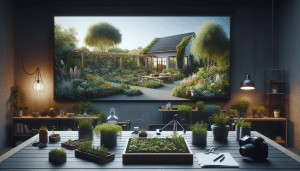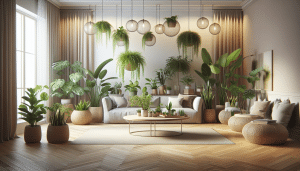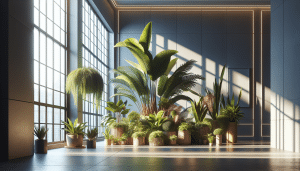Simple Ways You Can Transform a Small Garden
Daniel Fisher September 3, 2025
Discover clever tips for creating lush, lively outdoor spaces even in the tiniest gardens. This practical guide shares ideas for small garden design, affordable landscaping, container gardening, and smart plant choices, helping homeowners maximize every inch of their space.
Understanding Small Garden Design Principles
Transforming a small garden starts with understanding design basics that make the area feel larger and more inviting. Prioritizing functional zones allows for dedicated spaces like seating, planting, and pathways. Choosing a simple layout with strong lines and repeating patterns creates visual harmony without overwhelming a compact yard. Focal points, such as a decorative pot or garden sculpture, draw the eye and make a space feel intentionally planned. Clever small garden design enables an outdoor area to feel welcoming and organized, even if square footage is limited.
Tall plants, vertical trellises, and layered shrubbery add height, giving the impression of more space. Layering also means arranging short plants up front with taller greenery behind, playing with depth and dimension. This landscape design trick guides the eye and avoids a cluttered or flat appearance. Incorporating raised beds or wall-mounted shelves allows the use of vertical real estate, creating more planting opportunities in less ground space. Emphasizing vertical gardening can yield a surprisingly lush effect for small gardens.
Another essential element is color. Carefully selecting a calming, limited palette prevents a crowded look. Extending patio stone or decking in the same tones as nearby fences also creates visual continuity. Simple lines, restrained color schemes, and deliberate plant placement work together to make a compact outdoor space into a peaceful sanctuary. Integrating these small garden design fundamentals provides a foundation for further enhancements that capitalise on available space and resources. (Source: https://hgic.clemson.edu/factsheet/small-gardens/)
Making Smart Plant Choices in Compact Spaces
Smart plant selection is the foundation of thriving small garden landscaping. Start with compact shrubs and slow-growing ornamental trees that won’t overcrowd the yard. Dwarf evergreens, hydrangeas, and Japanese maples make great focal pieces without outgrowing their space. Many modern plant varieties are bred for patios and containers, providing dramatic form and color in a limited footprint. Selecting the right plants helps avoid ongoing pruning battles and ensures everything stays healthy and lush.
Mixing evergreen plants with perennials ensures the garden looks vibrant through all seasons. Evergreens provide reliable structure and privacy, while flowering perennials like salvias, coreopsis, or lavender fill beds with color and attract pollinators. Edible plants, including compact tomatoes, herbs, or berries, offer both beauty and utility. Smart plant combinations maximize every square foot, turning even small gardens into productive, diverse environments.
It’s important to consider not just appearance, but also ease of maintenance. Native plants or drought-tolerant options thrive in local climates and often need less water and attention. Incorporating pest-resistant varieties further reduces routine care, freeing up time to enjoy the garden instead of constantly tending to it. Putting thought into small garden plant selection means less hassle, lower costs, and a fuller, more enjoyable outdoor retreat. (Source: https://extension.colostate.edu/topic-areas/yard-garden/flowers-for-small-gardens-7-247/)
Creative Container Gardening for Flexible Spaces
Container gardening is a flexible solution for maximizing flower and vegetable options in a limited garden area. Pots, planters, and raised troughs can be relocated effortlessly, allowing experimentation with layout throughout the seasons. Grouping different containers at varied heights adds depth and visual interest even when there’s little room to spare. Using matching container styles tied together by color or material can elevate the look of a small garden, making it appear more thoughtfully composed.
Growing herbs, annuals, or even small fruit trees in containers keeps the garden productive and ever-changing. Lightweight planters allow for roof terraces or balconies, bringing greenery to spaces that might otherwise remain bare. Container setups make it easy to change displays year-round, refreshing the look for spring blooms, summer vegetables, or autumn foliage. This adaptability helps small gardens stay dynamic and full of fresh interest without any permanent hardscape changes.
Drainage and soil quality are key factors in container gardening. Using well-drained potting mix tailored to plant needs helps roots stay healthy and vigorous. Self-watering containers or drip systems further reduce maintenance, making it easier to keep displays lush even during busy months. With the right approach, container gardening transforms porches, steps, and patios into cheerful, easy-care oases that reflect evolving personal style. (Source: https://extension.psu.edu/container-gardening)
Affordable Landscaping Ideas for Every Budget
Landscaping improvements don’t have to be costly. Simple DIY pathways, such as gravel or stepping-stone trails, give structure and guide movement without expensive materials. Groundcovers like creeping thyme or clover serve as low-maintenance lawn alternatives and add texture. Repurposing salvaged wood, old bricks, or recycled pots lends charm and saves money, fitting well with small garden sustainability goals. Even basic mulches help suppress weeds and retain moisture, reducing the need for frequent watering.
Light features and mirrors can dramatically influence the feeling of space. String lights or solar-powered lanterns extend evening enjoyment at low cost. Well-placed garden mirrors reflect greenery and sky, doubling the apparent size and bringing extra sunlight to shaded corners. Vertical wall planters using upcycled pockets or wooden pallets also free up valuable ground space, amplifying visual impact without a large investment. Innovative yet affordable landscaping creates a rich atmosphere suited to all budgets.
Incorporating budget-friendly hardscape—like pea gravel patios or simple stepping-stone paths—keeps the design accessible. Raised garden beds made from untreated timber provide growing areas for vegetables or flowers, while also defining separate “rooms” within the garden. These simple touches help maximize the usability and aesthetics of small outdoor areas, making them places for gathering and relaxation. (Source: https://edis.ifas.ufl.edu/publication/EP450)
Optimizing Lighting and Privacy in Small Gardens
Lighting sets the mood in any garden, even in small spaces. Solar stakes, string lights, or low-voltage garden path lamps add a cozy glow that brings the area to life at dusk. Soft lighting enhances safety and highlights decorative features, such as a water fountain or statement plant. Layered light sources bring depth, making outdoor gatherings or solo evenings more delightful. Careful selection of lighting hardware ensures energy efficiency and long-term value for homeowners.
Privacy is crucial for making a small garden feel like its own retreat. Simple screens, bamboo fencing, or tall planters filled with dense greenery create secluded pockets without fully enclosing the space. Installing trellises with fast-growing vines, like jasmine or clematis, offers both coverage and fragrance. Adjustable solutions, such as movable screens or retractable awnings, let homeowners tailor privacy and shade as needed throughout the seasons. Enhancing privacy often improves both the enjoyment and the utility of compact gardens.
Combining practical lighting with creative privacy measures transforms any limited outdoor area into a welcoming, practical sanctuary. The right blend supports everything from relaxed afternoons with a book to small social occasions. Thoughtful design choices maximize comfort and function, making the most of every square inch. (Source: https://extension.umn.edu/landscape-design/landscape-design-securing-privacy)
Maintaining a Vibrant, Low-Effort Outdoor Retreat
Busy schedules mean easy-care gardens are especially popular. Choosing native, disease-resistant, and drought-tolerant plants cuts down on chore time while supporting local wildlife. Drip irrigation, automatic timers, and mulch work together to keep plants healthy with minimal input. A focus on well-chosen, resilient plant combinations lets small gardens look vibrant all season long, freeing up time to relax and enjoy.
Seasonal maintenance like pruning, deadheading, and soil enrichment can be planned in small, manageable blocks for efficiency. Keeping on top of simple daily or weekly routines helps prevent major issues, such as pest infestations or overgrown beds. Integrating compost bins or wormeries encourages sustainability, reducing waste and producing organic fertilizer for container and bed plantings. These practical strategies support a thriving outdoor haven without overwhelming upkeep.
Designing a small garden for low maintenance means more time spent enjoying the space rather than constantly working in it. Smart technology, well-suited plants, and strategic planning all contribute to a lively, easy-to-manage garden. A mix of personal touches ensures every compact outdoor area feels unique and rewarding, reflecting the homeowner’s style and needs. (Source: https://marinmg.ucanr.edu/BASICS/MAINTAIN/)
References
1. Clemson Cooperative Extension. (n.d.). Small Gardens. Retrieved from https://hgic.clemson.edu/factsheet/small-gardens/
2. Colorado State University Extension. (n.d.). Flowers for Small Gardens. Retrieved from https://extension.colostate.edu/topic-areas/yard-garden/flowers-for-small-gardens-7-247/
3. PennState Extension. (n.d.). Container Gardening. Retrieved from https://extension.psu.edu/container-gardening
4. University of Florida IFAS Extension. (n.d.). Landscaping on a Budget. Retrieved from https://edis.ifas.ufl.edu/publication/EP450
5. University of Minnesota Extension. (n.d.). Landscape Design: Securing Privacy. Retrieved from https://extension.umn.edu/landscape-design/landscape-design-securing-privacy
6. University of California Master Gardener Program. (n.d.). Maintain Your Landscape. Retrieved from https://marinmg.ucanr.edu/BASICS/MAINTAIN/








